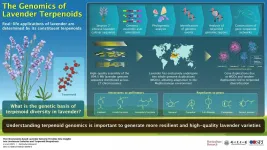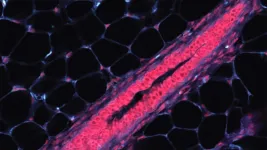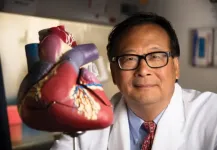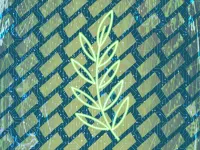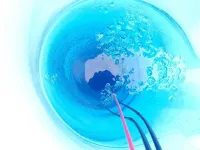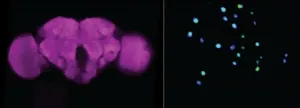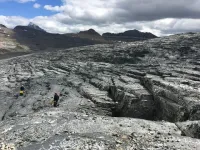(Press-News.org) Even the mention of lavender evokes the distinct fragrance of the flower. This beautiful flower has been used to make perfumes and essential oils since time immemorial. The aesthetics of the flower have captured the imagination of hundreds, worldwide. So, what makes this flower so special? What are the "magical" compounds that gives it its unique fragrance? What is the genetic basis of these compounds? These questions have long puzzled scientists.
To find out the answers, a group of scientists from China have sequenced the genome of lavender, which is known in the scientific world as Lavandula angustifolia. The team headed by Dr. Lei Shi, Professor at the Key Laboratory of Plant Resources and Beijing Botanical Garden, Institute of Botany, Chinese Academy of Sciences, was specifically interested in the genetics and diversity of a class of volatile terpenoids produced by lavender.
Terpenoids play important roles in the biology of fragrant flowers including lavender. In the environment, terpenoids have been shown to attract potential insect pollinators. In real-life applications, terpenoids lend their potential benefits, including stress relief and skin conditioning, through products like essential oils. Keeping these in mind, it is essential to understand the fundamentals of terpenoid biosynthesis at the genetic level to manipulate lavender to produce better quality of these compounds.
The team began by analyzing the high-quality reference genome data of the Chinese variety of lavender 'Jingxun 2'. Through phylogenetic analysis, they identified genomic events through the evolutionary history of lavender that led to the expansion of terpenoid biosynthetic genes in this species. Their analysis also yielded important insights into changes in these genes with respect to changes in the environment under which they grew.
Firstly, the scientists assembled the genetic sequences of the Chinese lavender cultivar. Next, they identified and named, or "annotated," the genomic regions in the lavender sequence and performed phylogenetic analysis on these sequences to better understand the evolutionary history of the lavender. Then they identified the events that affected the entire lavender genome and specifically the terpenoid producing genes. Finally, they associated genes on the lavender genome sequences with different terpenoids found in the plant, to construct gene-terpenoid networks.
Their results, published in a recent issue of Horticulture Research, reported the successful assembly of the 894.5 Mb lavender genome sequence distributed across 27 chromosomes, and could possibly be the best quality lavender sequence assembly, so far. In addition, the scientists were able to show that lavender has exclusively undergone major genetic events, including two whole genome duplications, which allowed them to better adapt and thrive in colder Mediterranean weather conditions.
Explaining their observations, Dr. Shi says, "Plants have the capacity to duplicate their genomes and when this happens there is freedom for the duplicated genes to evolve to do other things. This has allowed plants to develop new machinery to make a diverse array of chemical compounds that are used to defend against attack from harmful microbes and herbivores, and to attract beneficial species such as bees to assist in pollination." In fact, this explanation by Dr. Shi is supported by the findings of the team's study. His team identified gene duplications caused by the previously mentioned genetic events, which in turn led to terpenoid diversification. Upon further analysis, they also observed gene clusters specifically corresponding to attractive and defensive terpenoids.
Dr. Shi is excited about the potential real-life applications of this work. "The introduction of lavender into China can be traced back to the 1950s by pioneers of the Institute of Botany, The Chinese Academy of Sciences. Degradation of the cultivated species is of concern; hence, improved varieties are urgently needed. With a better understanding of the lavender genome, scientists will have an easier time developing new varieties, which may produce high-quality essential oils, have strong ornamental uses, and are resistant to pathogens and climate fluctuations.", he exclaims.
Sharing Dr. Shi's enthusiasm, we can indeed hope this study paves the way for better varieties of lavender and provide a template for research in plant volatile-environmental interactions.
INFORMATION:
Reference
Authors
Jingrui Li, Yiming Wang, Yanmei Dong, Wenying Zhang, Di Wang, Hongtong Bai, Kui Li, Hui Li, and Lei Shi
Title of original paper
The chromosome-based lavender genome provides new insights into Lamiaceae evolution and terpenoid biosynthesis
Journal
Horticulture Research
DOI
https://doi.org/10.1038/s41438-021-00490-6
Affiliations
Key Laboratory of Plant Resources and Beijing Botanical Garden, Institute of Botany, Chinese Academy of Sciences, Xiangshan 100093 Beijing, China
University of Chinese Academy of Sciences, 100015 Beijing, China
Novogene Bioinformatics Institute, 100083 Beijing, China
About Professor Lei Shi
Dr. Lei Shi has been a professor at Key Laboratory of Plant Resources and Beijing Botanical Garden, Institute of Botany, Chinese Academy of Sciences, China, since 2001. Dr. Shi is specifically interested in researching the fundamentals and applications of aromatic plants and their compounds. He completed his PhD from the Institute of Botany in 1999. He has led more than 30 projects; published more than 140 scientific papers and books; obtained 12 state-authorized patents; and facilitated the development of eight new certified plant varieties, including four species of Lavandula, two of Origanum, and two of Rosmarinus.
What if you could predict which cells might become cancerous? Breast tissue changes dramatically throughout a woman's life, so finding markers for sudden changes that can lead to cancer is especially difficult. Cold Spring Harbor Laboratory (CSHL) Associate Professor Camila dos Santos and her team identified and cataloged thousands of normal human and mouse breast cell types. The new catalog redefines healthy breast tissue so that when something goes awry, scientists can pinpoint its origin.
Any breast cell could become cancerous. Dos Santos says:
"To understand breast cancer risk, you have to understand normal breast cells first, so when we think about preventive and even targeting therapies, ...
BIRMINGHAM, Ala. - In a large-animal study, researchers have shown that heart attack recovery is aided by injection of heart muscle cells derived from human induced pluripotent stem cell line, or hiPSCs, that overexpress cyclin D2. This research, published in the journal Circulation, used a pig model of heart attacks, which more closely resembles the human heart in size and physiology, and thus has higher clinical relevance to human disease, compared to studies in mice.
An enduring challenge for bioengineering researchers is the failure of the heart to regenerate muscle tissue after a heart attack has killed part of its muscle wall. That dead tissue can strain the surrounding muscle, leading to a lethal heart enlargement.
Heart experts thus have sought to create new tissue -- applying ...
Inspired by nature, researchers at Pacific Northwest National Laboratory (PNNL), along with collaborators from Washington State University, created a novel material capable of capturing light energy. This material provides a highly efficient artificial light-harvesting system with potential applications in photovoltaics and bioimaging.
The research provides a foundation for overcoming the difficult challenges involved in the creation of hierarchical functional organic-inorganic hybrid materials. Nature provides beautiful examples of hierarchically structured hybrid materials such as bones and teeth. These materials typically showcase a precise atomic ...
HOUSTON - (May 14, 2021) - Rice University bioengineers are fabricating and testing tunable electrospun scaffolds completely derived from decellularized skeletal muscle to promote the regeneration of injured skeletal muscle.
Their paper in Science Advances shows how natural extracellular matrix can be made to mimic native skeletal muscle and direct the alignment, growth and differentiation of myotubes, one of the building blocks of skeletal muscle. The bioactive scaffolds are made in the lab via electrospinning, a high-throughput process that can produce single micron-scale fibers.
The research could ease the burden of performing an estimated ...
Scientists have used fibre-optic sensing to obtain the most detailed measurements of ice properties ever taken on the Greenland Ice Sheet. Their findings will be used to make more accurate models of the future movement of the world's second-largest ice sheet, as the effects of climate change continue to accelerate.
The research team, led by the University of Cambridge, used a new technique in which laser pulses are transmitted in a fibre-optic cable to obtain highly detailed temperature measurements from the surface of the ice sheet all the way to the base, more than 1000 metres below.
In contrast to previous studies, which measured temperature from separate sensors located tens or even hundreds of metres apart, the new approach allows temperature ...
A microscope used by Antoni van Leeuwenhoek to conduct pioneering research contains a surprisingly ordinary lens, as new research by Rijksmuseum Boerhaave Leiden and TU Delft shows. It is a remarkable finding, because Van Leeuwenhoek (1632-1723) led other scientists to believe that his instruments were exceptional. Consequently, there has been speculation about his method for making lenses for more than three centuries. The results of this study were published in Science Advances on May 14.
Previous research carried out in 2018 already indicated that some of Van Leeuwenhoek's microscopes contained common ground lenses. Researchers have now examined ...
In research made possible when COVID-19 sidelined other research projects, scientists at Johns Hopkins Medicine meticulously counted brain cells in fruit flies and three species of mosquitos, revealing a number that would surprise many people outside the science world.
The insects' tiny brains, on average, have about 200,000 neurons and other cells, they say. By comparison, a human brain has 86 billion neurons, and a rodent brain contains about 12 billion. The figure probably represents a "floor" for the number needed to perform the bugs' complex behaviors.
"Even though these brains are simple [in contrast to mammalian brains], they can do a lot of processing, even more than a supercomputer," says Christopher Potter, Ph.D., associate professor of neuroscience ...
Being treated fairly is important - but fairness alone isn't enough to make people feel valued in a workplace or other groups, new research suggests.
Researchers found that "distinctive treatment" - where a person's talents and qualities are recognised - provides this sense of value while also reinforcing their sense of inclusion. It also promotes mental health.
The findings suggest there is no conflict between "fitting in" and "standing out" in groups - in fact, they complement each other.
But while the importance of fairness is widely accepted, the researchers say distinctive treatment is ...
AMES, Iowa - The field photos show the hard, rough country that some glaciers slide over: rocky domes and bumps in granite, rocky steps and depressions in limestone. The glacier beds dwarf the researchers and their instruments. (As do the high mountains pictured on the various horizons.)
During their trips to glacier beds recently exposed by retreating glaciers in the Swiss Alps (Rhone, Schwarzburg and Tsanfleuron glaciers) and the Canadian Rockies (Castleguard Glacier), four glaciologists used laser and drone technology to precisely measure the rocky beds and record their very different contours.
The researchers turned the measurements into high-resolution digital models of those glacier beds. Then they went to work with manageable but representative subunits of the ...
Better designed vaccines for insect-spread viruses like dengue and Zika are likely after researchers discovered models of immature flavivirus particles were originally misinterpreted.
Researchers from The University of Queensland and Monash University have now determined the first complete 3D molecular structure of the immature flavivirus, revealing an unexpected organisation.
UQ researcher Associate Professor Daniel Watterson said the team was studying the insect-specific Binjari virus when they made the discovery.
"We were using Australia's safe-to-handle Binjari virus, which we combine with more dangerous viral genes to make safer and more effective vaccines," Dr Watterson ...
